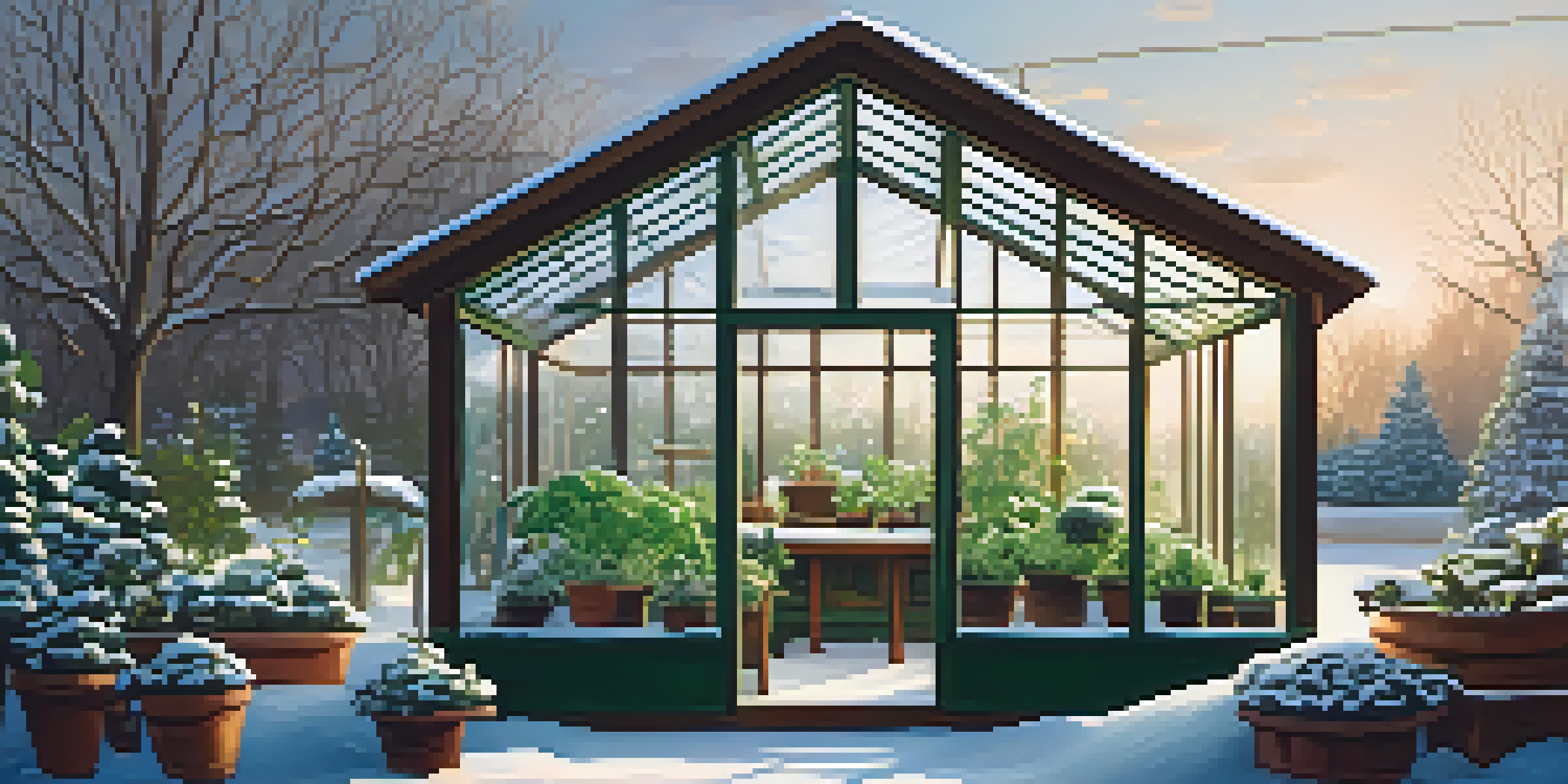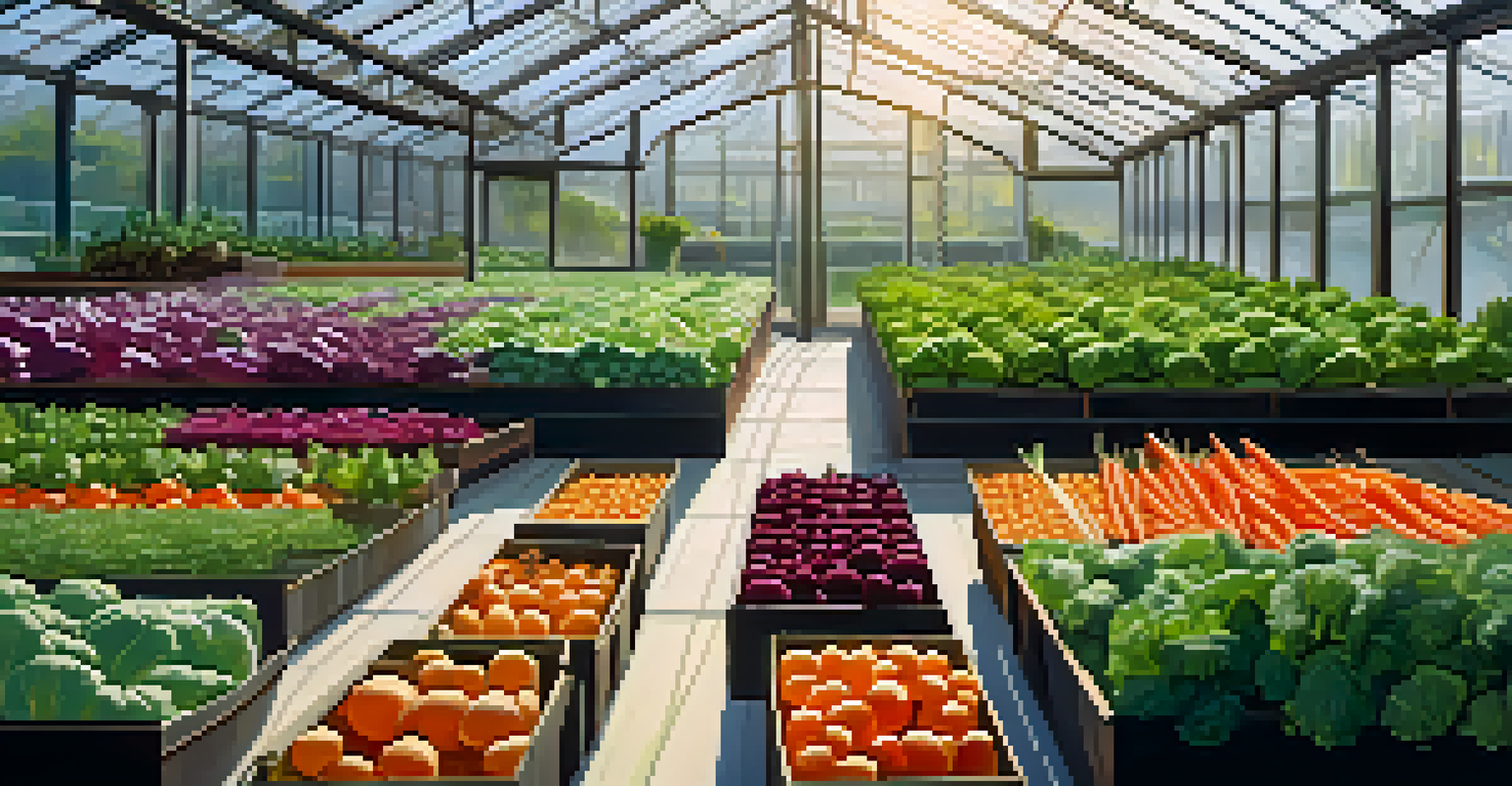Utilizing Greenhouses for Successful Cold Climate Gardening

Understanding the Benefits of Greenhouses in Cold Climates
Greenhouses offer a unique solution for gardeners in cold climates, providing a protective environment that shields plants from harsh weather. With controlled temperature and humidity, greenhouses create a microclimate that allows for extended growing seasons. This means you can start planting earlier in the spring and continue harvesting later into the fall.
Gardening is a way of showing that you believe in tomorrow.
In addition to extending the growing season, greenhouses can significantly improve plant health. They keep plants safe from pests and diseases that thrive in colder temperatures. This controlled environment also reduces the stress on plants, allowing them to grow more robust and productive.
Moreover, greenhouses can help gardeners conserve resources. By harnessing solar energy, they can reduce heating costs and reliance on artificial lighting. This not only saves money but also supports sustainable gardening practices, making it a win-win for both your wallet and the planet.
Choosing the Right Greenhouse for Your Needs
Selecting the right greenhouse is crucial for successful cold climate gardening. There are various types available, including freestanding, attached, and lean-to greenhouses. Each type caters to different space requirements and gardening goals, so consider your available space and how much gardening you plan to do.

Materials also play an essential role in greenhouse performance. Options like polycarbonate, glass, or even high-quality plastic can affect insulation and light transmission. For cold climates, consider opting for double-walled materials, which provide better insulation and help maintain a stable temperature inside the greenhouse.
Greenhouses Extend Growing Seasons
Greenhouses create a protective microclimate that allows gardeners in cold climates to start planting earlier and harvest later.
Additionally, think about the size of your greenhouse. A larger space allows for more plants, but a smaller greenhouse can still be effective for growing a variety of crops. Assess your gardening aspirations and choose a size that fits both your ambitions and your available space.
Essential Greenhouse Accessories for Cold Weather Gardening
To maximize your greenhouse's potential, certain accessories can make a significant difference in cold climates. Heating systems, such as electric or propane heaters, are vital for maintaining optimal temperatures during frigid nights. You can also consider using thermal mass materials, like water barrels, to help retain heat.
The best time to plant a tree was twenty years ago. The second best time is now.
Ventilation is another crucial aspect to keep in mind. Proper airflow helps prevent mold and keeps temperatures in check during the day. Installing automatic vents or fans can help regulate humidity and ensure your plants are breathing well, even when the temperatures outside drop.
Don’t forget about the importance of lighting. In cold climates, especially during shorter winter days, supplemental grow lights can help your plants thrive. LED grow lights are energy-efficient and can provide the necessary spectrum for optimal plant growth, making them a smart choice for any greenhouse.
Soil and Plant Selection for Cold Climate Greenhouses
Choosing the right soil is vital for successful greenhouse gardening. A well-draining potting mix enriched with organic matter can provide the nutrients your plants need while preventing waterlogging. Additionally, consider adding perlite or vermiculite to improve aeration and drainage, essential in colder months.
When it comes to plant selection, cold-hardy varieties are your best friends. Crops like kale, spinach, and certain varieties of carrots and beets thrive in cooler temperatures and can be planted earlier in the season. This allows you to enjoy fresh produce even when outdoor conditions are less than ideal.
Choose the Right Greenhouse Type
Selecting the appropriate greenhouse style and materials is essential for optimizing gardening efforts in cold weather.
It’s also beneficial to stagger your planting schedule. By sowing seeds in intervals, you can harvest at different times and extend your growing season even further. This technique not only maximizes the use of your greenhouse but also keeps your table full of fresh vegetables throughout the year.
Watering Techniques for Greenhouse Plants in Cold Weather
Watering greenhouse plants can be tricky, especially in cold weather. It's essential to monitor moisture levels diligently, as cold air can dry out soil faster than you might expect. Using a moisture meter can help you gauge when your plants need a drink without overdoing it.
Consider using a drip irrigation system, which delivers water directly to the roots and minimizes evaporation. This method is particularly effective in maintaining consistent moisture levels, crucial for plant health during fluctuating temperatures. Additionally, it saves time and energy, allowing you to focus on other gardening tasks.
Remember that watering should be adjusted according to the season. In colder months, plants may require less frequent watering, so be attentive to their needs. Keeping a close eye on your plants will help you determine the right balance, ensuring they stay hydrated without becoming waterlogged.
Managing Pests and Diseases in Your Greenhouse
Even in a controlled environment, pests and diseases can still be a challenge in greenhouse gardening. Regular inspections are vital to catch any issues early, so make it a habit to check your plants frequently. Look for signs of pests, like discolored leaves or webbing, and act swiftly to address any problems.
Implementing natural pest control methods can be very effective. Beneficial insects, like ladybugs and lacewings, can help keep harmful pests at bay without the need for harsh chemicals. Additionally, introducing companion planting can create a balanced ecosystem that deters pests naturally and promotes healthy plant growth.
Essential Care for Greenhouse Plants
Regular maintenance, including proper watering and pest management, is crucial for ensuring healthy plant growth in a greenhouse.
Preventive measures, such as maintaining cleanliness and proper watering practices, can also contribute to a pest-free environment. Clean tools and pots can significantly reduce the risk of introducing diseases. By taking these proactive steps, you can enjoy a thriving greenhouse without the constant worry of pest invasions.
Seasonal Care Tips for Your Cold Climate Greenhouse
Seasonal care is crucial for maintaining a productive greenhouse throughout the year. In fall, prepare your greenhouse for winter by cleaning it thoroughly and checking for any necessary repairs. Removing debris and old plants not only keeps it tidy but also reduces the risk of disease during the colder months.
During winter, focus on insulation and heating. Covering your greenhouse with thermal blankets at night can help retain warmth. Be sure to monitor the temperatures regularly and adjust your heating systems as needed to keep your plants cozy and thriving.

As spring approaches, start planning for your new growing season. This is the perfect time to assess your past gardening successes and failures. Reflect on what worked and what didn’t, allowing you to make informed decisions for your upcoming crops, ensuring your greenhouse remains a flourishing sanctuary for plants.